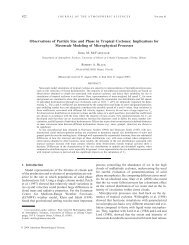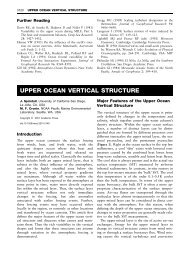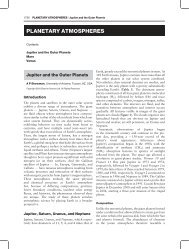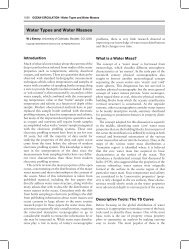Chapt 2.5 [PDF]
Chapt 2.5 [PDF]
Chapt 2.5 [PDF]
You also want an ePaper? Increase the reach of your titles
YUMPU automatically turns print PDFs into web optimized ePapers that Google loves.
<strong>2.5</strong>
Reversible<br />
Irreversible<br />
In all thermodynamic processes, the changes<br />
that occur in the environment must be<br />
considered in conjunction with the changes<br />
that occur in the thermodynamic system<br />
System<br />
environment
Reversible<br />
The system is in an equilibrium state<br />
throughout the process<br />
The system passes at an infinitesimal<br />
rate through a continuous succession<br />
of balance states that are<br />
infinitesimally different from each<br />
other<br />
A<br />
B<br />
The process can be reversed and the<br />
system and its environment will return<br />
to the initial state<br />
v1<br />
v2<br />
adiabatic process<br />
dq<br />
= 0
Irreversible<br />
If the system is restore to its initial<br />
state, the environment will have change<br />
The term irreversible does not mean that the system<br />
cannot return to its original state<br />
System<br />
Cannot be restored<br />
environment
example<br />
precipitation<br />
If the rain falls to the ground<br />
The total water content of the<br />
atmosphere<br />
Temperature of the atmosphere<br />
Irreversibly
pv =<br />
RT<br />
dh<br />
=<br />
c<br />
p<br />
dT<br />
First law in<br />
enthalpy form<br />
for a reversible<br />
process<br />
dh = dq +<br />
vdp<br />
c p<br />
dT = dq + vdp<br />
dq = c<br />
pdT<br />
−<br />
vdp<br />
v =<br />
RT<br />
p<br />
RT<br />
dq = c<br />
pdT<br />
− dp<br />
dq c<br />
pdT<br />
R<br />
= − dp<br />
p T T p<br />
dq<br />
T<br />
=<br />
c<br />
p<br />
d(lnT<br />
)<br />
−<br />
Rd(ln<br />
p)<br />
dq<br />
T<br />
⎛ dq ⎞<br />
Exact differential<br />
∫ ⎜ ⎟ =<br />
⎝ T ⎠<br />
rev<br />
0<br />
Only for a<br />
reversible<br />
process
Entropy<br />
η<br />
dη<br />
=<br />
⎛<br />
⎜<br />
⎝<br />
dq<br />
T<br />
⎟<br />
⎠<br />
⎞<br />
rev<br />
Change in entropy from<br />
one state to the other<br />
defined associated<br />
with a reversible<br />
process<br />
Exactly the same for<br />
an irreversible<br />
process<br />
state variable<br />
⎛ dq ⎞<br />
∫ ⎜ ⎟ = 0<br />
⎝ T ⎠<br />
rev<br />
but<br />
∫<br />
⎛<br />
⎜<br />
⎝<br />
dq<br />
T<br />
⎟<br />
⎠<br />
⎞<br />
Reversible<br />
Irreversible<br />
∫<br />
⎛<br />
⎜<br />
⎝<br />
dq<br />
T<br />
⎞<br />
⎟<br />
⎠<br />
rev<br />
><br />
∫<br />
⎛<br />
⎜<br />
⎝<br />
dq<br />
T<br />
⎟<br />
⎠<br />
⎞<br />
irrev
∫<br />
⎛<br />
⎜<br />
⎝<br />
dq<br />
T<br />
⎞<br />
⎟<br />
⎠<br />
rev<br />
><br />
∫<br />
⎛<br />
⎜<br />
⎝<br />
dq<br />
T<br />
⎟<br />
⎠<br />
⎞<br />
irrev<br />
To accomplish a given change in<br />
entropy (or state)<br />
Irreversible<br />
More heat<br />
A<br />
B<br />
Reversible<br />
More efficient!!<br />
v1<br />
v2
Entropy changes for an ideal gas<br />
dq<br />
T<br />
=<br />
c<br />
p<br />
d(lnT<br />
)<br />
−<br />
Rd(ln<br />
p)<br />
Internal energy form<br />
dT c v<br />
=<br />
dq<br />
−<br />
pdv<br />
RT dq<br />
p = = cv d(lnT<br />
) + Rd(ln<br />
v)<br />
v T<br />
dη<br />
= c<br />
pd(lnT<br />
) −<br />
Rd(ln<br />
p)<br />
dη<br />
= cv d(lnT<br />
) +<br />
Rd(ln<br />
v)
dη = c<br />
pd(lnT<br />
) − Rd(ln<br />
p)<br />
dη<br />
= cv d(lnT<br />
) + Rd(ln<br />
v)<br />
dp = 0<br />
Isobaric heating<br />
dη<br />
=<br />
c<br />
p<br />
d(lnT )<br />
Δη<br />
= ∫<br />
T<br />
T<br />
1<br />
2<br />
c<br />
p<br />
dT<br />
T<br />
Δη = c p<br />
ln T<br />
T 2<br />
1<br />
Isothermal heating<br />
dT = 0 d η = − Rd (ln p)<br />
= Rd (ln v)<br />
Δη<br />
=<br />
R<br />
⎛<br />
ln<br />
⎜<br />
⎝<br />
p ⎞ ⎛<br />
1 ⎟ = R ln<br />
⎜<br />
p<br />
2 ⎠ ⎝<br />
v<br />
v<br />
2<br />
1<br />
⎞<br />
⎟<br />
⎠
Physical interpretation…<br />
measure of the "multiplicity" associated<br />
with the state of the objects.<br />
"throwing dice",<br />
If a given state can be accomplished<br />
in many more ways, then it is more<br />
probable than one which can be<br />
accomplished in only a few ways.<br />
7<br />
2<br />
throwing a seven is<br />
more probable than a<br />
two because you can<br />
produce seven in six<br />
different ways and<br />
there is only one way<br />
to produce a two.<br />
So seven has a higher multiplicity<br />
than a two, and we could say that a<br />
seven represents higher "disorder" or<br />
higher entropy.
Relationship between entropy and probability<br />
Two isolated bulbs<br />
Volume doubles<br />
V<br />
V<br />
V<br />
V<br />
Calculate the change in entropy<br />
Δη<br />
=<br />
⎛<br />
Nk ln<br />
⎜<br />
⎝<br />
v<br />
v<br />
fin<br />
init<br />
⎞<br />
⎟<br />
⎠<br />
N = 4 v = 1 = 2<br />
k<br />
init<br />
v fin<br />
Boltzmann constant (gas<br />
constant per molecule)<br />
Δη = 4k ln 2<br />
4<br />
Δη = k ln 2<br />
The entropy change is<br />
proportional to ln 16
probabilities<br />
One configuration for the<br />
initial state: All four<br />
molecules in the left bulb<br />
V<br />
V<br />
16 ways of arranging the four<br />
molecules between the 2 bulbs<br />
# in left bulb<br />
# in right<br />
bulb<br />
# of waves to archive<br />
configuration, C<br />
Probability of the<br />
configuration, P<br />
1<br />
3<br />
0<br />
4<br />
1<br />
1/16<br />
2<br />
4<br />
1<br />
2<br />
3<br />
2<br />
4<br />
6<br />
4/16<br />
6/16<br />
3<br />
1<br />
4<br />
4/16<br />
4<br />
0<br />
1<br />
1/16<br />
1<br />
3<br />
Total: 16 1<br />
4<br />
2<br />
p<br />
p<br />
fin<br />
init<br />
=<br />
C<br />
C<br />
fin<br />
init<br />
=16
The equilibrium state of the four molecules<br />
distributed in two bulbs is more random than<br />
four molecules in one bulb<br />
We are less definitive<br />
about the location of the<br />
molecules in the more<br />
“disordered” state<br />
The natural path of all processes is from order to randomness<br />
ENTROPY IN AN ISOLATED SYSTEM WILL TEND<br />
TO INCREASE AS THE PROBABILITY SPREADS<br />
OUT OVER THE POSSIBLE STATES AND THE<br />
SYSTEM APROACHES EQUILIBRIUM


![Chapt 2.5 [PDF]](https://img.yumpu.com/24218624/1/500x640/chapt-25-pdf.jpg)





